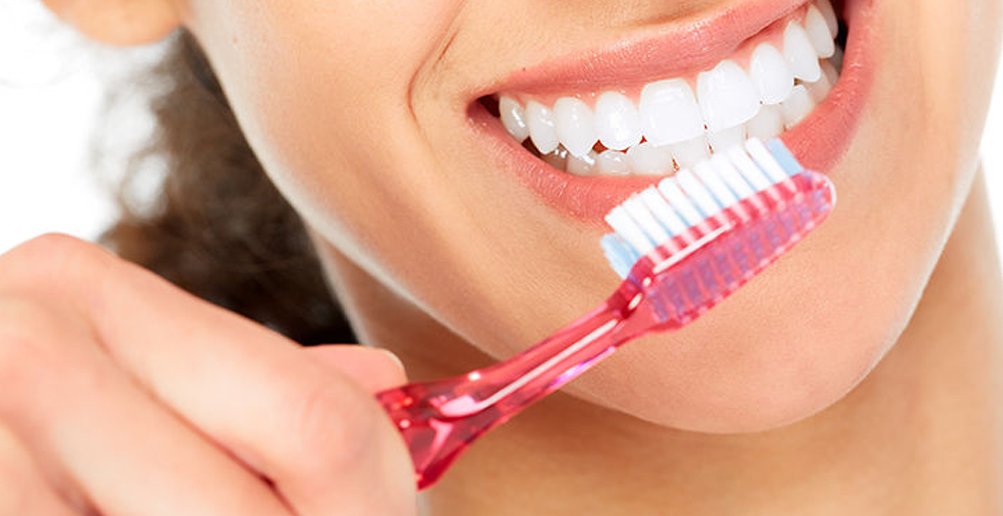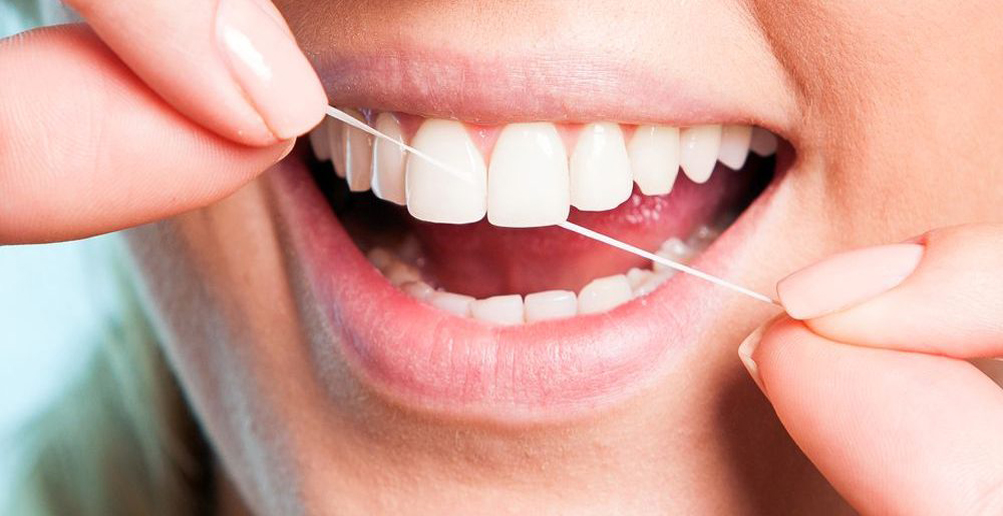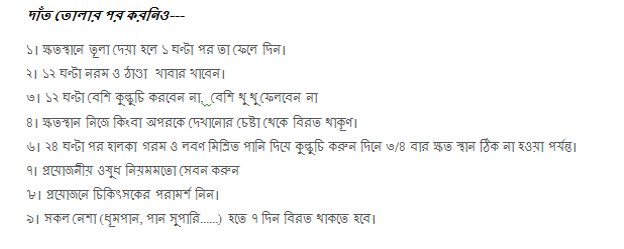Call Us
015 52 39 3921
Advice
Experienced Dentists and Orthodontist in Dhaka, Bangladesh

BRUSHING:
Brushing your teeth is an important part of your dental care routine. For a healthy mouth and smile the SMILE Gallery recommends you:
- Brush your teeth twice a day with a soft-bristled brush. The size and shape of your brush should fit your mouth allowing you to reach all areas easily.
- Replace your toothbrush every three or four months, or sooner if the bristles are frayed. A worn toothbrush won't do a good job of cleaning your teeth.
- Make sure to use an fluoride toothpaste.
- Place your toothbrush at a 45-degree angle to the gums.
- Gently move the brush back and forth in short (tooth-wide) strokes.
- Brush the outer surfaces, the inner surfaces, and the chewing surfaces of the teeth.
- To clean the inside surfaces of the front teeth, tilt the brush vertically and make several up-and-down strokes.
- Follow the video link Given above.
The proper brushing technique is to:

FLOSSING OF TEETH:
Dental floss dislodges food particles trapped between the teeth and under the gums where tooth brushes can't reach. Left unchecked, bacterial buildup can lead to cavities, bad breath, and gum diseases.
We know we should floss at least once a day, but not everyone knows the right way to do it. Use this step-by-step guide to find out how to properly floss your teeth:

Break off about 18 inches of floss and wind most of it around one of your middle fingers. Wind the remaining floss around the same finger of the opposite hand. This finger will take up the floss as it becomes dirty.

Hold the floss tightly between your thumbs and forefingers.

Guide the floss between your teeth using a gentle rubbing motion. Never snap the floss into the gums

When the floss reaches the gum line, curve it into a C shape against one tooth. Gently slide it into the space between the gum and the tooth.

Hold the floss tightly against the tooth. Gently rub the side of the tooth, moving the floss away from the gum with up and down motions. Repeat this method on the rest of your teeth. Don't forget the back side of your last tooth.
Once you're finished, throw the floss away. A used piece of floss won't be as effective and could leave bacteria behind in your mouth.
Extractions:
- Slight oozing of bleed for 12 hours is a normal condition. Do not panic. Just relax.
- Take painkillers as prescribed by your dentist or oral surgeon.
- To help relieve pain and swelling, apply an ice or cold pack to the outside of your mouth for 10 to 20 minutes at a time. Put a thin cloth between the ice and your skin.
- After 24 hours, rinse your mouth gently with warm salt water several times a day to reduce swelling and relieve pain. Make your own salt water by mixing 1 tsp (5 g) of salt in a medium-sized glass [8 fl oz (240 mL)] of warm water. Do not rinse hard. This can loosen the blood clot and delay healing.
- Remove cotton/ gauze pads before they become soaked with blood.
- Relax after surgery. Physical activity may increase bleeding.
- Avoid smoking.
- Eat soft foods, such as gelatin, pudding, or a thin soup. Gradually add solid foods to your diet as healing progresses.
- Do not lie flat. This may prolong bleeding. Prop up your head with pillows.
- Avoid rubbing the area with your tongue.
Tooth Whitening:
- For 48 hours after you have your tooth whitening procedure, avoid foods and drinks that will likely stain your teeth:
- coffee and tea
- colas
- red wine
- berry fillings in pies or other baked goods
- tobacco products
- Be sure to floss daily and brush with an anti-sensitivity toothpaste and clean your tongue carefully at least twice each day
- Over-the-counter pain relievers containing ibuprofen or acetaminophen may reduce any pain or sensitivity you feel.
- Take over-the-counter pain relievers if you experience tooth pain or sensitivity after whitening.
Implant:
- Be careful: When your mouth is numb, it's very easy to bite your tongue or the inside of your cheek.
- If the dental implant area continues to bleed place a sterile gauze pad on the area and bite down on it firmly. Maintain pressure for a half-hour, and the bleeding should have stopped. If it does not stop, call us right away.
- If you are experiencing discomfort and swelling in the implant area, you may apply an ice pack wrapped in a soft cloth to the outside of your cheek closest to the implant.
- Take any prescribed pain medication when the anesthetic wears off; if not prescribed pain medication or pain is mild to moderate, take over-the-counter Tylenol, Advil, or Motrin in the normal dose.
- It's best to avoid hot or hard foods on the day your implants are placed. Instead, drink plenty of fluids and soft foods that day. However, return to your normal diet the following day if at all possible.
- Do not rinse, spit, or touch the implant area after your surgery.
- Keep physical activity low after surgery so you don't disturb the implant site, causing yourself discomfort or unnecessary bleeding.
- If you experience any sensitivity to hot or cold foods and drinks in the weeks following your implant surgery, use sensitivity-reducing toothpaste. (You may also notice temporary sensitivity to sweet foods, air, or extreme temperatures.) If your sensitivity lasts more than two weeks, please call our office.
Dental Bridge:
- Do not eat for at least 30 minutes after the bridge is placed. The cement used to put the bridge in place needs 30 minutes to set.
- Do not chew hard or especially chewy food for at least 24 hours from when your bridge is placed.
- Brush and floss normally after eating and at bedtime.
- Return for regular six-month checkups after placement of your permanent bridge.
As with any dental procedure, after-care is important after receiving a temporary or permanent bridge. Restorations should last for many years as long as you continue practicing good dental hygiene and receiving regular checkups with your dentist.
Night Guard:
To care for your custom-fitted night guard:
- Wash the night guard after every wearing with water or mouthwash and dry it before closing in its case.
- At least once a week, brush your mouth guard gently with toothpaste or mild soap, then rinse and dry.
- At least once a week, clean your mouth guard case with soap and water.
- Keep your night guard in its case when you are not wearing it.
- Don't store your night guard in the bathroom. High humidity may cause it to warp and/or get mildewed.
- Check your mouth guard periodically for damage.
Filling:
- After you have a composite filling, you may want to avoid eating hard, crunchy foods until the numbness has passed. When your mouth is numb, it's very easy to bite your tongue or the inside of your cheek!
- You may experience mild pain or discomfort radiating from your jaw after having any kind of filling, and you can treat it with over-the-counter pain medications such as ibuprofen or acetaminophen.
- If your pain is radiating from or localized on a tooth, please call your dentist as soon as possible. You may have an infection, which needs to be treated, or your new filling may have been placed a little high on the tooth, so it needs to be reshaped.
- Consider using a sensitivity-reducing toothpaste for a few weeks after a filling if you are experiencing discomfort due to sensitivity.
- If your sensitivity lasts more than two weeks after your new filling has been placed, please call our office.
Sensitive Teeth:
- Maintain good oral hygiene. Be sure to use a soft-bristled toothbrush, and follow proper brushing techniques. If you need instruction on effective brushing, please ask your dentist or one of our hygienists for information.
- Consider using sensitivity-reducing toothpaste for a few weeks after dental procedure if you are experiencing discomfort due to sensitivity.
- Use a sensitivity-reducing toothpaste daily if you have a diagnosed ongoing dental problem that is causing sensitivity.
- If you have unexplained sensitivity in any tooth or teeth for more than a week, please give us a call so we can diagnose the cause of your sensitivity.
- If you've had a dental procedure and sensitivity lasts more than two weeks afterward, please call us.
If you are suffering from tooth sensitivity, and it is painful for more than a moment at a time, take an over-the-counter pain reliever and apply a warm compress to your cheek on the side where sensitivity is occurring

